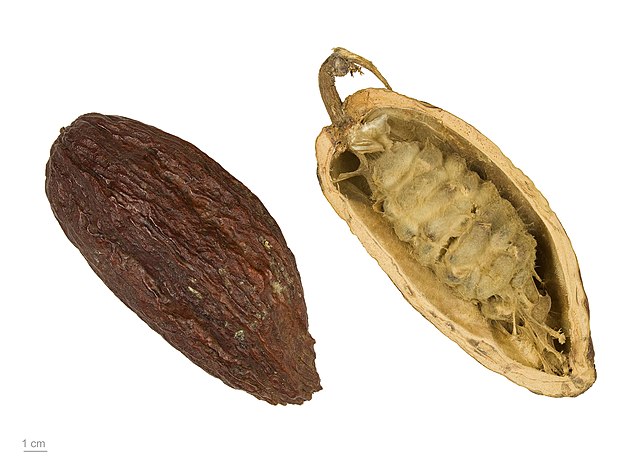Cocoa:
What is it?, history, cultivation, nutritional value, uses, recipes, and more...
Cocoa is the plant that provides the raw material from which chocolate is made. Chocolate, aside from being delicious and universally appreciated, contains highly beneficial nutrients for the body, such as fats, carbohydrates, and proteins.
Índice
What is Cocoa?
Cocoa is a tree that typically measures between 5 and 8 meters in height, although it can reach up to 20 meters when growing freely under shade. It has a dense and rounded canopy, with a diameter of 7 to 9 meters. The trunk tends to be straight and can develop in various forms depending on environmental conditions.
The cocoa root system consists of a main taproot and many secondary roots, which are located in the top 30 cm of soil.
The leaves of this plant are simple, entire, and come in various shades of green (light brown, purple or reddish, pale green) with short petioles.
Its flowers are small in size and grow in small clusters around the sites where leaves were previously located. The calyx is pink with pointed parts, the corolla is whitish, yellow, or pink. The petals are long.
The fruits usually have a berry shape, measuring approximately 30 centimeters in length and 10 centimeters in diameter. They can be smooth or ribbed, elliptical in shape, and come in red, yellow, purple, or brown hues. The fruit’s exterior is thick, hard, or soft. Inside, the fruits are divided into five cells. The pulp can be white, pink, or brown, with an acidic, sweet, and aromatic flavor. Each berry contains 20 to 40 seeds, which can be flat or round, and have a white, brown, or purple color with a sweet or bitter taste.
Cocoa trees start producing fruits 3 to 4 years after planting, and it is estimated that they can produce good cocoa for 30 years from that point onwards.
History of Cocoa
Legend has it that cocoa was the most beautiful tree in the Aztecs’ paradise, with multiple virtues attributed to it, such as calming hunger and thirst, providing universal wisdom, and curing diseases.
It is believed that the first cocoa trees grew naturally in the tropical jungles of the Amazon and Orinoco basins about 4,000 years ago, and the Mayans began cultivating it over 2,500 years ago.
For the Mayans, cocoa symbolized physical energy and longevity. It was used as medicine, and the doctors of that time prescribed it as a relaxant, stimulant, and restorative. Cocoa butter was also used as an ointment to heal wounds.
The Mayans created a bitter beverage called “chocolha” made from cocoa seeds, which was consumed exclusively by nobles and kings. There are descriptions of various methods of preparation and flavoring, making it more liquid or thick, with more or less foam, and adding honey, corn, or spicy chili.
When the Aztecs conquered the Mayan territory, they also gained access to cocoa, reserving it for the elites and warriors. Due to its scarcity, it was highly prized, and its seeds were used as a form of currency.
It is known that Christopher Columbus was officially the first Westerner to taste the beverage in 1502 during a trip to Nicaragua, although he was not particularly impressed by the flavor.
In 1528, Hernán Cortés introduced cocoa to Europe for the first time. However, it was considered a very astringent and not very pleasant-tasting product, so it initially did not receive much attention. It was only when the monks in Spain adapted the beverage to European tastes by adding honey (or sugar), milk, and spices (such as vanilla and cinnamon) that it became a beverage of interest, limited to consumption by members of the court.
Despite its exclusive treatment, chocolate spread to other countries, such as France, thanks to the marriage between María Teresa of Spain and Louis XIV, the Sun King, as the bride was a great aficionado of this beverage.
From Paris, France, it quickly spread throughout Europe (in cities such as London, Amsterdam, Ghent, among others). Its high demand led to the rapid expansion of cocoa cultivation. The Spanish attempted to cultivate it in Hispaniola (now Haiti and the Dominican Republic) and Trinidad, with little success, and later in Ecuador with better results (1635).
The Dutch, who had conquered Curaçao, began cultivating cocoa there from 1620, the French in Martinique, Saint Lucia, and Brazil, while the English did so in Jamaica. The Spanish African colonies also began cocoa cultivation. It began to be cultivated on the island of Bioko (then called Fernando Poo), and from there the seeds spread to Nigeria (1874), Ghana (1879), and Cameroon (1925-39).
Thanks to cocoa from the Spanish colonies, the metropolis obtained the raw material that allowed them to develop the consumption of chocolate and cocoa-based beverages. Currently, over 70% of the cocoa consumed worldwide comes from West Africa (Ivory Coast, Ghana, Cameroon, among others).
In Peru, cocoa is one of the main organic crops that have replaced coca cultivation in the fight against drug trafficking. With state and international support, as well as local networks, thousands of families in the Peruvian rainforest (especially in the VRAEM region) have abandoned illicit coca cultivation in favor of cocoa cultivation as a means to change their lives and move forward. The success of this project has been so significant that Peru is currently the 8th largest producer of cocoa in the world.

Common name of Cocoa
| Español | Cacao, árbol del cacao o cacaotero |
| Francés | cacao |
| Italiano | cacao |
| Portugués | cacau |
| Alemán | Kakao |
| Ruso | какао |
| Inglés | cocoa |
Scientific name of Cocoa
Theobroma cacao
Taxonomy of Cocoa
| Reino | Plantae |
| Subreino | Tracheobionta |
| División | Magnoliophyta |
| Clase | Magnoliopsida |
| Subclase | Dilleniidae |
| Familia | Malvaceae |
| Subfamilia | Byttnerioideae |
| Tribu | Theobromeae |
| Género | Theobroma |
| Especie | T. cacao L. |
Synonymy of Cocoa
Cacao minar Gaertn.
Cacao minus Gaertn.
Cacao sativa Aubl.
Cacao theobroma Tussac
Theobroma cacao f. leiocarpum (Bernoulli) Ducke
Theobroma cacao leiocarpum (Bernoulli) Cuatrec.
Theobroma cacao var. leiocarpum (Bernoulli) Cif.
Theobroma cacao sativa (Aubl.) León
Theobroma cacao var. typica Cif.
Theobroma caribaea Sweet
Theobroma integerrima Stokes
Theobroma kalagua De Wild.
Theobroma leiocarpum Bernoulli
Theobroma pentagonum Bernoulli
Theobroma saltzmanniana Bernoulli
Theobroma sapidum Pittier
Theobroma sativa (Aubl.) Lign. & Le Bey
Theobroma sativa var. leucosperma A.Chev.
Theobroma sativa var. melanosperma A. Chev.
Theobroma sativum (Aubl.) Lign. & Bey
Etymology of Cocoa
Theobroma: a Greek word that means “food of the gods.”
Cocoa: The word “cocoa” comes from the Aztec word “cacahuatl,” which refers to the name of the plant.
Habitat of Cocoa
- Habitat
Habitat of Cocoa
Cocoa is a plant that usually grows in lowland tropical areas. It thrives best under shade, as it cannot tolerate direct sunlight. It has an annual temperature limit of 21°C and cannot withstand lower temperatures. The cultivation of cocoa requires shade to prevent direct sunlight and to increase the temperature. Flowering is normal and abundant at temperatures around 25°C. It requires soil with good drainage and is sensitive to both drought and waterlogging. Flooding or waterlogging can lead to root asphyxiation and death in a short period of time. It needs about 1500 to 2500 mm of water in the warmer lowland areas and 1200 to 1500 mm in cooler areas or high valleys.
Cocoa thrives in soils rich in organic matter, with deep, loamy clay soils, good drainage, and regular topography. Plantations can be found in a wide range of soil types, from highly eroded heavy clays to newly formed volcanic sands and silts. It prefers pH levels ranging from 4.0 to 7.0. In general, cocoa is a plant that successfully develops in a wide diversity of soil types.
Geographical Distribution of Cocoa

Madre de Dios, Ucayali, San Martin, Huánuco, Amazonas, Cuzco, Cajamarca, Tumbes, Piura, Ayacucho, Junín, Pasco.
Seasonal Availability of Cocoa
- Available year-round
Varieties of Cocoa
There are numerous varieties of cocoa classified into three botanical groups:
-
Criollo
-
Forastero
-
Trinitario
Nutritional Value of Cocoa
The main components of cocoa are fats and carbohydrates. The fats come from cocoa butter, which contains a significant amount of stearic acid, a saturated fatty acid that does not raise blood cholesterol levels unlike other similar acids.
Additionally, cocoa contains theobromine, a substance that exerts a tonic effect on the body, promotes diuresis, and stimulates blood circulation.
Cocoa also provides vitamins A and B, as well as minerals such as calcium, phosphorus, iron, magnesium, copper, and potassium. It is worth noting that adding milk to chocolate significantly increases its calcium content. Cocoa also contains folic acid and thiamine (B1), which are essential nutrients for metabolic regulation.
Moreover, the polyphenols found in cocoa prevent the oxidation of cholesterol and could be essential compounds in preventing cardiovascular disorders and boosting the body’s defenses.
While cocoa is high in calories, its energy contribution makes it highly recommended for sports or intense physical activity.
Health Benefits of Cocoa
Cocoa provides a wide variety of fats, carbohydrates, minerals, vitamins, calories, and other essential nutrients for the body.
Contraindications or Side Effects
Cocoa is generally safe for the majority of people. However, some individuals may experience allergic reactions on the skin, migraines, and digestive problems.
People with bleeding disorders, anxiety, or diarrhea should consume it in moderation, as well as pregnant and breastfeeding women.
Caution is necessary when consuming cocoa for individuals with diabetes, gastroesophageal reflux disease (GERD), or irregular heartbeats.
Additionally, due to its caffeine content, cocoa should be avoided by individuals with heart disease, diarrhea, glaucoma, high blood pressure, irritable bowel syndrome (IBS), or osteoporosis.
It’s also important to note that cocoa can be highly toxic to dogs and other animals, so it is recommended to keep it out of their reach.
| 10 Porciones por Kilogramo | |
| Tamaño de porción | 100g |
| Cantidad por porción Calorías |
570 |
| Cantidad por 100g | |
| Energía | 2,387 kJ |
| Grasa Total | 46.3 g |
| Sodio | ● |
| Carbohidratos totales | 34.7 g |
| Carbohidratos disponibles | ● |
| Fibra Dietaria | ● |
| Proteínas | 12.0 g |
| Calcio | 106 mg |
| Fósforo | 537 mg |
| Zinc | ● |
| Hierro | 3.60 mg |
| Potasio | ● |
| Agua | 3.6 g |
| Cenizas | 3.4 g |
| Vitamina A | 0 μg |
| Tiamina (B1) | 0.17 mg |
| Riboflavina (B2) | 0.14 mg |
| Niacina (B3) | 1.70 mg |
| Vitamina C | 3.00 mg |
| Acido Fólico (B9) | ● |
| β-Caroteno | ● |
| Fuente: Tablas peruanas de composición de alimentos – Centro Nacional de Alimentación y Nutrición – Ministerio de Salud – Perú | |
Derived Products and Forms of Cocoa Consumption
Uses of Cocoa
The quintessential use of cocoa is in the form of chocolate, one of the most versatile and beloved culinary ingredients in the world. Beyond the various forms in which this product can be found in global gastronomy, cocoa also offers significant health benefits and has made its way into the pharmaceutical and cosmetic industries.
- Culinary
- Medicinal
- Industrial
- Ritual
Culinary Use of Cocoa
While we all know cocoa as the foundation of chocolate, not everyone is aware that its culinary uses go far beyond confectionery and hot beverages. Chocolate can also be employed in numerous recipes, both sweet and savory.
Chocolate can be used to prepare countless desserts. It is used as a coating for artistic work and decoration, as well as to add flavor to creams. Cocoa powder is used in baking, and there is baking chocolate available in specialized stores. There is also dark chocolate, melted chocolate used for tempering, and other chocolate presentations such as chocolate chips or grated chocolate for decoration, among many others.
Chocolate can also be used in various savory dishes that can serve as main courses or snacks. One of the most well-known examples is Mexican mole, a thick sauce that combines pure chocolate with onion, garlic, chicken, and other ingredients.
Medicinal Use of Cocoa
Cocoa, in the form of chocolate, is considered a natural strengthener that is easily digestible and even an aphrodisiac. It was sold in pharmacies as a restorative tonic until the 19th century.
Its properties derive from the action of alkaloids in cocoa beans, which produce stimulating, antioxidant, and antitussive effects. Some of its medicinal uses include:
Increasing energy levels. Cocoa is a natural stimulant due to its vasodilating action, which enhances blood flow.
Improving mood. It is believed that consuming cocoa increases serotonin levels in the brain, resulting in a sense of relaxation and well-being.
Additionally, cocoa can help lower blood pressure and suppress coughing.
Industrial Use of Cocoa
Cocoa is utilized by both the pharmaceutical and food industries. The pharmaceutical industry extracts theobromine to create commercial diuretics and nervous system stimulants. Cocoa butter is also extracted from the seeds for use in ointments or suppositories.
In the cosmetic industry, cocoa is used in various creams due to its moisturizing and hydrating properties, as well as its content of vitamins A and C. It also possesses firming and detoxifying properties that are beneficial for skincare.
Ritual Use of Cocoa
In Mesoamerica, the Mayans and Aztecs used chocolate for ritual purposes among warriors and priests, as well as in religious ceremonies and celebrations.
They believed it was discovered by the gods, who bestowed it upon humans. The Mayans held an annual festival featuring rituals in honor of the god of cocoa, Ek Chuah. Archaeological evidence of these ceremonies can still be found today.
- cdn.www.gob.pe
- gestion.pe
- ecured.cu
- elperuano.pe
- researchgate.net
- objetivobienestar.com
- es.wikipedia.org
- cuidateplus.marca.com
- es.wikipedia.org
- elsevier.es
- thefoodtech.com
- directoalpaladar.com
- observatoriodelcacao.com
- peru.info
- peru.info
- herbazest.com
- infocafes.com
- redhistoria.com
- natureduca.com
- vozdeamerica.com
- indifferentlanguages.com



